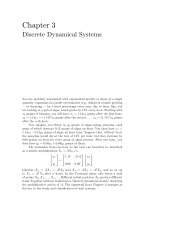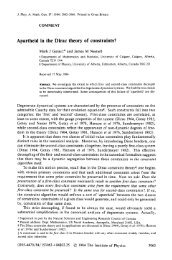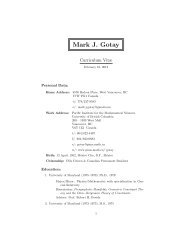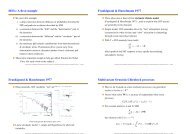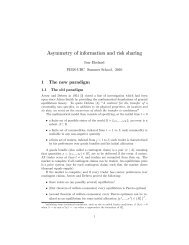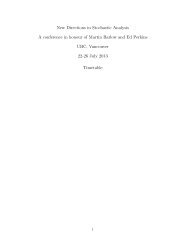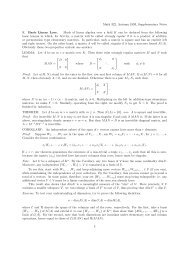17 PRIMA 2013 AbstractsSpecial Session 8Hyperbolic Conserv<strong>at</strong>ion Laws and Rel<strong>at</strong>edApplic<strong>at</strong>ionsSome counterexamples in the theory of conserv<strong>at</strong>ionlawsAlberto BressanPennsylvania St<strong>at</strong>e University, USAbressan@m<strong>at</strong>h.psu.eduThe first part of the talk is concerned with sticky particlemodels in two space dimensions. Examples of Cauchyproblems can be constructed with two and with zero solutions,respectively. Similar ideas apply to the equ<strong>at</strong>ionsof pressureless gases in two space dimensions, with L ∞initial d<strong>at</strong>a.The second set of examples concern the p-system of isentropicgas dynamics. For initial d<strong>at</strong>a with large totalvari<strong>at</strong>ion, one can arrange repe<strong>at</strong>ed wave-front interactionsin such a way th<strong>at</strong> the total strength of all wavefronts becomes arbitrarily large.Nonlinear mixed type equ<strong>at</strong>ions arisen inMach reflectionShuxing ChenFudan University, Chinasxchen@fudan.edu.cnIn the study of Mach reflection we find a kind of nonlinearmixed type equ<strong>at</strong>ions. The solvability of the generalizedTricomi problem of the mixed type equ<strong>at</strong>ion leads thestability of corresponding Mach configur<strong>at</strong>ion.Self-similar vortex spiral solutions of the 2dincompressible Euler Equ<strong>at</strong>ionsVolker EllingUniversity of Michigan, Ann Arbor, USAvelling@umich.eduVortex spirals are ubiquitous in fluid flow, for example asturbulent eddies or as trailing vortices <strong>at</strong> aircraft wings.However, there are few proofs of existence for any of thecommon fluid models. We consider solutions of the incompressibleEuler equ<strong>at</strong>ions th<strong>at</strong> have vorticity str<strong>at</strong>ifyinginto algebraic spirals. The solutions are selfsimilar:velocity v(t, x) = t m−1 v(t −m x), for similarity exponent1< m < ∞. Selfsimilar flows are special solutions of the2full initial-value problem, but obtained by solving moretractable boundary value problems. The key to the existenceproof is an coordin<strong>at</strong>e change which is implicit,depending on the a priori unknown solution. We willalso discuss the importance of the program for showingnon-uniqueness in the initial-value problem for the 2d incompressibleEuler solutions.Some results about compressible Oldroyd-BDaoyuan FangZhejiang University, Chinadyf@zju.edu.cnIn this talk, I will show some results about the compressibleOldroyd-B model, which is the joint work withRuizhao Zi. For such medel, we proved th<strong>at</strong> the systemadmits a unique local strong solution with initial densityvanishes from below, and give a blow-up criterion; Inthe framework of critical spaces, we establish the globalsolutions if the initial d<strong>at</strong>a and coupling constant are sufficientlysmall. We also proved th<strong>at</strong> as the Mach numbertends to zero, the global solution converges to the solutionto the corresponding incompressible model in somefunction spaces,and obtained a kind of the converge r<strong>at</strong>es.Shock reflection and von Neumann conjecturesMikhail FeldmanUniversity of Wisconsin-Madison, USAfeldman@m<strong>at</strong>h.wisc.eduWe discuss shock reflection problem for compressible gasdynamics, and von Neumann conjectures on transitionbetween regular and Mach reflections. Then we describerecent results on existence of regular reflection solutionsfor potential flow equ<strong>at</strong>ion up to the detachment angle,and discuss some techniques. The approach is to reducethe shock reflection problem to a free boundary problemfor a nonlinear equ<strong>at</strong>ion of mixed elliptic-hyperbolic type.Open problems will also be discussed. The talk will bebased on the joint work with Gui-Qiang Chen.Normal forms and a Burgers-Hilbert equ<strong>at</strong>ionJohn K. HunterUniversity of California, Davis, USAjkhunter@ucdavis.eduThe Burgers-Hilbert equ<strong>at</strong>ion arises as a model equ<strong>at</strong>ionfor the motion of a vortex p<strong>at</strong>ch or vorticity discontinuityin a two-dimensional, inviscid, incompressible fluid flow,and describes the effect of nonlinear steepening on an interfaceor wave th<strong>at</strong> oscill<strong>at</strong>es <strong>at</strong> a constant backgroundfrequency. For small amplitudes, these oscill<strong>at</strong>ions delaywave breaking. We will explain how non-standardnormal form methods can be used to prove an enhancedlife-span of small smooth solutions of the Burgers-Hilbertequ<strong>at</strong>ion in comparison with the inviscid Burgers equ<strong>at</strong>ion.These normal form methods can be applied to otherquasilinear wave equ<strong>at</strong>ions, for which the Burgers-Hilbertequ<strong>at</strong>ion provides a useful test case. This is joint workwith M. Ifrim, D. T<strong>at</strong>aru, and D. Wong.Incompressible limit of the non-isentropicideal magnetohydrodynamic equ<strong>at</strong>ionsSong JiangInstitute of Applied Physics and Comput<strong>at</strong>ional M<strong>at</strong>hem<strong>at</strong>ics,Chinajiang@iapcm.ac.cnWe first give a short review of results on the low Machnumber limit for the compressible magnetohydrodynamicequ<strong>at</strong>ions. Then, we study the incompressible limit of thecompressible non-isentropic ideal magnetohydrodynamicequ<strong>at</strong>ions with general initial d<strong>at</strong>a in the whole space IR d(d = 2, 3), and establish the existence of classic solutionson a time interval independent of the Mach number. Finally,by deriving uniform a priori estim<strong>at</strong>es, we obtainthe convergence of the solution to th<strong>at</strong> of the incompressiblemagnetohydrodynamic equ<strong>at</strong>ions as the Mach numbertends to zero.(joint-work with Q.C. Ju and F.C. Li)The Cauchy problem to the Kazhikhov-Vaigant model in compressible flowQuansen JiuCapital Normal University, Chinajiuqs@mail.cnu.edu.cnIn this talk, we will present some recent progresses ofthe global well-posedness of the Cauchy problem to the
18 PRIMA 2013 AbstractsKazhikhov-Vaigant model which is a kind of compressibleNavier-Stokes equ<strong>at</strong>ions with the shear viscosity µ a positiveconstant and the bulk viscosity λ is a power functionof the density.The initial d<strong>at</strong>a can be arbitrarily large tocontain vacuum st<strong>at</strong>es. This is joint with Yi Wang andZhouping Xin.Global solutions for transonic self-similar twodimensionalRiemann problemsEun Heui KimCalifornia St<strong>at</strong>e University, Long Beach, USAEunHeui.Kim@csulb.eduWe discuss the recent development of multi-dimensionaltransonic Riemann problems. More precisely we discussanalytical results and numerical results on a simplifiedmodel system – the nonlinear wave system.Long Time behaviors of the Vlasov-Poisson-Boltzmann Equ<strong>at</strong>ionsHai-Liang LiCapital Normal University, Chinahailiang.li.m<strong>at</strong>h@gmail.comThis talk is concerned with the long time behaviors ofglobal solution to the Vlasov-Poisson-Boltzmann (VPB)equ<strong>at</strong>ions with binary elastic collision of hard sphere asthe initial d<strong>at</strong>a is a small perturb<strong>at</strong>ion of the globalMaxwellian. In terms of the spectrum analysis of linearizedsystem and energy estim<strong>at</strong>es, the optimal timedecay r<strong>at</strong>es of global solution is established, and the influenceof electric filed governed by the self-consistent Poissonequ<strong>at</strong>ion on the distribution of the spectra and thetime-asymptotical behaviors are justified.Traveling waves of chemotaxis modelsTong LiUniversity of Iowa, USAtong-li@uiowa.eduWe study global existence and long time behavior of classicalsolutions for a hyperbolic-parabolic system derivedfrom the Keller-Segel model describing chemotaxis. Weestablish the existence and the nonlinear stability of largeamplitudetraveling wave solutions to the system of nonlinearconserv<strong>at</strong>ion laws derived from Keller-Segel model.Asymptotic behavior of solutions to Euler-Poisson equ<strong>at</strong>ions for bipolar hydrodynamicmodel of semiconductorsMing MeiChamplain College Saint-Lambert and McGill University,Canadammei@champlaincollege.qc.ca, ming.mei@mcgill.caIn this talk, we study the Cauchy problem for 1-D Euler-Poisson system, which represents a physically relevanthydrodynamic model but also a challenging case for abipolar semiconductor device by considering two differentpressure functions and a non-fl<strong>at</strong> doping profile. Differentfrom the previous studies for the case with two identicalpressure functions and zero doping profile, we realize th<strong>at</strong>the asymptotic profiles of this more physical model aretheir corresponding st<strong>at</strong>ionary waves (steady-st<strong>at</strong>e solutions)r<strong>at</strong>her than the diffusion waves. Furthermore, weprove th<strong>at</strong>, when the flow is fully subsonic, by means ofa technical energy method with some new development,the smooth solutions of the system are unique, exist globallyand time-algebraically converge to the correspondingst<strong>at</strong>ionary solutions. The optimal algebraic convergencer<strong>at</strong>es are obtained.This is a joint work with D. Don<strong>at</strong>elli, B. Rubino and R.SampalmieriCompressible Navier-Stokes equ<strong>at</strong>ions withChapman dissip<strong>at</strong>ionRonghua PanGeorgia Institute of Technology, USApanrh@m<strong>at</strong>h.g<strong>at</strong>ech.eduFrom its physical origin, the viscosity and he<strong>at</strong> conductivityin compressible fluids depend on absolute temper<strong>at</strong>urethrough power laws. The m<strong>at</strong>hem<strong>at</strong>ical theory onthe well-posedness and regularity on this setting is widelyopen. I will report some recent progress made on thisdirection, with emphasis on the lower bound of temper<strong>at</strong>ure,and global existence of solutions in one or multipledimensions. The rel<strong>at</strong>ion between thermodynamics lawsand Navier-Stokes equ<strong>at</strong>ions will also be discussed. Thistalk is based on joint works with Weizhe Zhang.Stability of steady st<strong>at</strong>e solutions for Euler-Maxwell equ<strong>at</strong>ionsYue-Jun PengBlaise Pascal University, Francepeng@m<strong>at</strong>h.univ-bpclermont.frWe consider Euler-Maxwell equ<strong>at</strong>ions arising in the modelingof magnetized plasmas. For such equ<strong>at</strong>ions steadyequilibrium st<strong>at</strong>es with zero velocity exist. For small initiald<strong>at</strong>a, we show global existence of smooth solutionswith convergence toward the steady st<strong>at</strong>es as the timegoes to infinity. In this problem, the main ingredient isan induction argument on the order of the deriv<strong>at</strong>ives ofsolutions in energy estim<strong>at</strong>es. It is also efficient to obtainthe global stability of solutions with exponential decaynear steady st<strong>at</strong>es for Euler-Poisson equ<strong>at</strong>ions.Traveling waves for slow erosionWen ShenPennsylvania St<strong>at</strong>e University, USAshen_w@m<strong>at</strong>h.psu.eduWe consider an integro-differential equ<strong>at</strong>ion th<strong>at</strong> describesthe slow erosion of granular flow in one space dimension,{(u t+exp ∫ +∞xu(x, 0) = ū(x).)f(u x(t, y)) dy =0, xHere u(x, t) denotes the height of the standing profile<strong>at</strong> the point (x, t), and the time variable t denotes theamount of mass th<strong>at</strong> passes through. The function f(u x)is the erosion function, which denotes the r<strong>at</strong>e of erosion(or deposition if neg<strong>at</strong>ive) per unit mass per distancetravelled. In a normalized model, f(1) = 0, indic<strong>at</strong>ing acritical slope u x = 1 where no erosions or depositionsoccur.Due to the nonlinearity of the function f, various typesof singularities will form in the solution u(x, t), includingkinks (jumps in u x) and shocks (jumps in u). Existenceof BV solutions is proved in [4], and semi-group solutionsare established in [2], using a modified form of wave fronttracking approxim<strong>at</strong>ion. In the simpler case where u xdoes not blow up, uniqueness of solutions is also achieved[1].In this talk we construct particular forms of travelingwave solutions for (1), which connect to x = ±∞ with(1)
- Page 2 and 3:
1PRIMA 2013-Table of ContentsTable
- Page 4 and 5:
3PRIMA 2013-OrganizationOrganizatio
- Page 6 and 7:
5PRIMA 2013-OrganizationYoshikazu G
- Page 8 and 9:
7PRIMA 2013-Useful InformationUsefu
- Page 10 and 11:
9PRIMA 2013-Useful InformationTaxi:
- Page 12 and 13:
11PRIMA 2013-Useful Informationmath
- Page 14 and 15: 13PRIMA 2013 Program-Schedule-at-a-
- Page 16 and 17: 15PRIMA 2013 Program-Monday, June 2
- Page 18 and 19: 17PRIMA 2013 Program-Monday, June 2
- Page 20 and 21: 19PRIMA 2013 Program-Monday, June 2
- Page 22 and 23: 21PRIMA 2013 Program-Monday, June 2
- Page 24 and 25: 23PRIMA 2013 Program-Tuesday, June
- Page 26 and 27: 25PRIMA 2013 Program-Tuesday, June
- Page 29 and 30: 28PRIMA 2013 Program-Tuesday, June
- Page 31 and 32: 30PRIMA 2013 Program-Tuesday, June
- Page 33 and 34: 32PRIMA 2013 Program-Wednesday, Jun
- Page 35 and 36: 34PRIMA 2013 Program- Thursday, Jun
- Page 37 and 38: 36PRIMA 2013 Program- Thursday, Jun
- Page 39 and 40: 38PRIMA 2013 Program- Thursday, Jun
- Page 41 and 42: 40PRIMA 2013 Program- Thursday, Jun
- Page 43 and 44: 42PRIMA 2013 Program- Friday, June
- Page 45 and 46: 44PRIMA 2013 Program- Friday, June
- Page 48 and 49: 1 PRIMA 2013 AbstractsContents1 Pub
- Page 50 and 51: 3 PRIMA 2013 Abstractsof subfactors
- Page 52 and 53: 5 PRIMA 2013 AbstractsprocessesXu S
- Page 54 and 55: 7 PRIMA 2013 AbstractsIn this talk
- Page 56 and 57: 9 PRIMA 2013 Abstractsindependently
- Page 58 and 59: 11 PRIMA 2013 AbstractsEnumerating,
- Page 60 and 61: 13 PRIMA 2013 AbstractsRyuhei Uehar
- Page 62 and 63: 15 PRIMA 2013 AbstractsIn this talk
- Page 66 and 67: 19 PRIMA 2013 Abstractscritical slo
- Page 68 and 69: 21 PRIMA 2013 AbstractsSpecial Sess
- Page 70 and 71: 23 PRIMA 2013 Abstractsstrictly awa
- Page 72 and 73: 25 PRIMA 2013 AbstractsPedram Hekma
- Page 74 and 75: 27 PRIMA 2013 Abstractsis well-know
- Page 76 and 77: 29 PRIMA 2013 Abstractssolid substr
- Page 78 and 79: 31 PRIMA 2013 AbstractsRapoport-Zin
- Page 80 and 81: 33 PRIMA 2013 Abstractssense. Our a
- Page 82 and 83: 35 PRIMA 2013 AbstractsIn an econom
- Page 84 and 85: 37 PRIMA 2013 AbstractsKyoto Univer
- Page 86 and 87: 39 PRIMA 2013 AbstractsAlexander Mo
- Page 88 and 89: 41 PRIMA 2013 AbstractsOsamu SaekiK
- Page 90 and 91: 43 PRIMA 2013 Abstractsopen Delzant
- Page 92 and 93: 45 PRIMA 2013 AbstractsJian ZhouTsi
- Page 94 and 95: 47 PRIMA 2013 AbstractsJiaqun WeiNa
- Page 96 and 97: 49 PRIMA 2013 Abstractsthe end of 2
- Page 98 and 99: 51 PRIMA 2013 AbstractsJongyook Par
- Page 100 and 101: 53 PRIMA 2013 AbstractsPancyclicity
- Page 102 and 103: 55 PRIMA 2013 AbstractsEfficient nu
- Page 104 and 105: 57 PRIMA 2013 Abstractsand fountain
- Page 106: 59 PRIMA 2013 Abstractsformula esti



